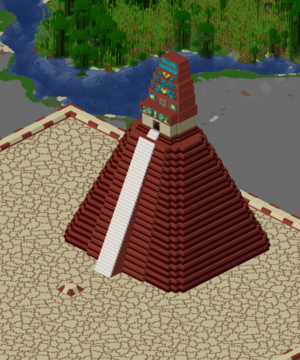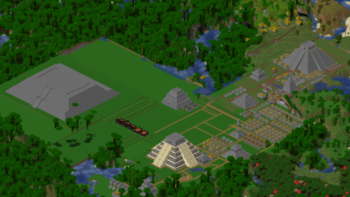Tikal: Difference between revisions
No edit summary |
No edit summary |
||
| Line 32: | Line 32: | ||
<div class="element">'''Amount of Temples:''' | <div class="element">'''Amount of Temples:''' | ||
* | * 'Total:' 1 | ||
* Rulers: 0 | * Rulers: 0 | ||
Revision as of 22:16, 5 April 2024

- Total: 238
- Rulers: 188
- Elite: 50
- Wealthy: 0
- Prosperous: 0
- Regular: 0
- Total: 70
- Rulers: 59
- Elite: 11
- Wealthy: 0
- Prosperous: 0
- Regular: 0
- 'Total:' 1
- Rulers: 0
- Elite: 1
- Wealthy: 0
- Prosperous: 0
- Regular: 0
Tikal is a Mesoamerican megacity, created in the Second Phase, and rebuilt in the third phase.
History
The Second Phase

In the Second Phase, Tikal is one of the largest cities in the world, possibly the largest. It is an Organic City. Tikal at the time was the Aztec capital of the Third Aztec Empire. However, once the Aztec empire formed the Fourth Aztec Empire, Tikal was no longer the capital. Instead the also quite large city, Tenochtitlan, became the new capital of the Aztecs. Following the formation of the fourth Aztec empire, the Aztecs made a plan to make all nations believe the Aztecs longer existed. Tikal would be defended poorly by the Aztecs, making it fall into Egyptain, Greek, Roman and Japanese hands. The plan worked and Tikal was conquered by the Egyptains, Romans and Greeks. The Japanese eventually retreated before fully annexing Tikal. After this, Tikal would be abandoned. Tikal inhabitants would be tortured mostly by the Egyptains. Montezuma II officially moved the capital to Tenochtitlan.
The Third Phase
After having a small role in the Second Phase, the Mayas entered the Third Phase much more powerful. They helped the Aztecs end the second phase and therefore were allowed a large empire by the Aztecs. The Mayas built their new capital, Tikal. This time Tikal was a Planned City.
Total population: 238
- Rulers: 188
- Elite: 50
- Wealthy: 0
- Prosperous 0
- Regular: 0
Total amount of houses: 70
- Rulers: 59
- Elite: 11
- Wealthy: 0
- Prosperous: 0
- Regular: 0
Total amount of temples : 1 (excluding Sacred Precinct)
- Rulers: 0
- Elite: 1
- Wealthy: 0
- Prosperous: 0
- Regular: 0
Description
City Plan
Tikal is a city with a large population and landmass. In the center is the Sacred Precinct, which has one temple, the Gran Jaguar, also known as Templo I. Around the sacred precinct are luxurious houses labeled as "ruler" houses. These belong to politicians, generals, rich men. This is followed up by "elite" people. These are often influencial men and military personnel (Generals, officers, liueutenants, etc). Following that further out are wealthy people. These people still often live in luxury but with more people in one house. These people are often semi-succesful businessmen and regular soldiers. Further out are the "prosperous" people. These people specialise in one subject. For example smiths or librarians. Though you see this in the higher classes aswell, they are more common in the prosperous class. The furthest out are the "regular" people. These are most often farmers or any other type of work that requires a large amount of energy and time.
Opinions
Tikal is a clear example of a large city with a clear class system. Some countries criticize the Mayas for this class system. According to these countries it's unfair for regulars to get better work and a higher place in society. Furthermore these countries say this is a unnatural way of controlling a city. Other countries praise the class system of Tikal. These countries state that the way this system works is more organized and keeps people in their place, preventing chaos.
Pros and Cons
In Tikal this class system and city plan have caused problems but also advantages. The socioeconomic segregation causes politicians and generals to be safer from protests, as the wealthier people dont protest much. On the contrary farmers and other poorer citizens might protest quicker. Due to the distance between the classes, they remain safer from violence. Another benefit from this system is organization. Wealthier people have places to work and poorer people have places to work. This keeps them seperated from eachother and to the eyes of these people, makes it seem more fair. Poorer people see no rich people which keeps them away from jealousy. A disadvantage of this system, is that poorer people do not easily see how much richer some people are, which leads to large gaps in between these classes. Also, in times of war, for example the Second Battle of Tikal, if poorer areas get damaged, the costs to repair this are smaller. That is an advantage. However, on the contrary, if wealthier areas are damaged, the costs are much larger. Therefore if a battle is fought closely to the precinct it might cause large economic problems. Furthermore, to keep the system in place, the city cannot expand with new rich houses. It would have to expand with small poorer houses. If Tikal were to continue expanding with rich houses on the outside of Tikal, the system would get chaotic. This would lead to problems. Therefore they'd have to improve the houses from the middle to outside first before expanding further. This means there will be less expansion, which causes Tikal to grow slower than cities that do not care too much about these types of systems.